The post Woodworking Gains Popularity at this Retirement Village appeared first on Woodworking | Blog | Videos | Plans | How To.
]]>Green Ridge Village (GRV) is a Continuing Care Retirement Village in south central Pennsylvania nestled in 350 wooded acres. About 170 Independent Living Residents are inspired by, and take full advantage of, access to the natural beauty of the area, as well as the cultural amenities afforded by nearby universities and metropolitan centers. However, the jewel in the crown of GRV is the newly expanded Wood Workshop.
Housed in a building adjoining the Green Ridge & Big Spring Model Railroad, the Wood Shop is “Home Sweet Home,” The woodworkers are retired from wide-ranging careers in government, academic and private sectors. They bring to woodworking the leadership and personal skills they honed as military and spiritual leaders, educators, researchers, librarians, farmers, program managers, musicians and artisans. Monthly meetings are lively with storytelling and creative approaches to “fix it a different way,” using “found” resources and repurposing strategies.
Some woodworkers learned the craft at a parent’s knee, and carry that precious linkage from their early years through life. These members form the backbone of the woodworkers’ group, deriving joy not only from sharing ideas among fellow, highly skilled members, but also mentoring and enabling the neophytes.
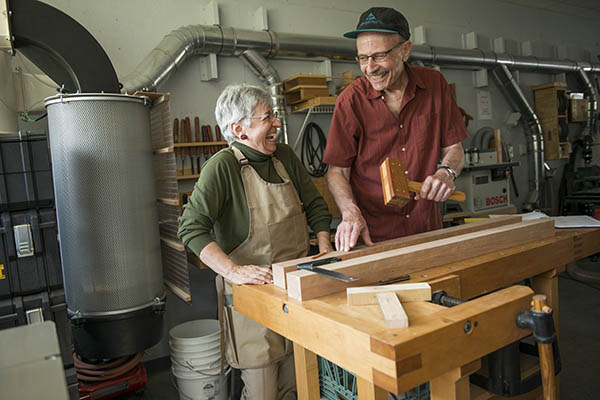
Here’s my personal perspective as a female neophyte: “I had no experience in woodworking, having spent my professional time as a molecular biologist, conducting scientific research and managing large research programs. It was not until I entered the woodshop at GRV, inhaled the fragrance of newly sawed wood, and listened to one of the woodworkers speak of his love of the craft that I could even imagine the prospect of learning myself. Members of the shop took me as a pure novice, trained and certified me so that I might overcome fears and use power tools safely, and set my feet on the path to becoming a woodworker.
“I learned how to design and plan a project, about the characteristics of different kinds of wood, how to examine the mechanical aspects and artistic appeal of the wood, and the unexpectedly large number of techniques required to embark on my first project: a cherry wood bench. Each step along the way, from cutting the boards, through creating double-tapered legs on a tailor-made jig, dado cuts, mortise-and-tenon joining, to finishing. Oh, the delights of “wipe-on-poly!”
“I first watched and listened to my teacher, Dan Cash, demonstrating the way, and then executed the moves myself. By the time I finished my very first project, I don’t know who was more proud: my mentor, myself or my husband. Not a woodworker himself, but possessing a critical eye, he marveled at the quality of my first project. I had tears in my eyes when I presented my project to the cheers and approval of my fellow members at a monthly meeting.”
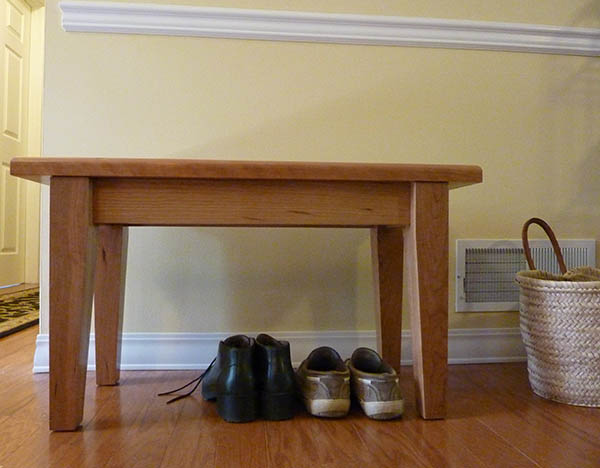
It’s perhaps not surprising that the woodworking group was so helpful, as the group’s bylaws themselves emphasize helping others with volunteer projects.
We always have a list of small projects to work on, and periodically receive requests for larger projects. Examples of past projects include fixing jewelry, rewiring lamps, hanging shelves, rebuilding chairs, making and crafting birdhouses. Larger projects include designing and crafting a new speakers’ podium, rebuilding the interior of a chapel, stripping and staining 14 pieces of outside furniture, and building 80-plus television stands for the nursing care unit.
Additionally, one of the more recent projects was a podium made of solid cherry wood. The member designed it with a wheel feature such that it can be moved like a wheelbarrow (tilt and push). It is used at the entryway to Green Ridge Village’s dining room and, though not heavy, can be easily moved by petite servers.
When the GRV library needed a display table for new books, one woodworker used a photograph to design and construct a solid cherry wood table for about $300, rather than the $1,600 cost of a veneer-over-chipboard commercial model. The Skilled Care nursing staff now use a cabinet measuring seven feet tall, three feet wide and two feet deep to store their medicines, courtesy of the GRV Wood Workers.
The woodworkers also addressed a problem of incompatibility of tables and chairs purchased from different vendors for the Skilled Care area. The arms of the chairs did not fit under the tables, but GRV woodworkers had a solution. Operating in a compressed timeframe to avoid interruption of meal services, they speedily raised the height of all the tables by three-quarters of an inch!
In addition to such projects for GRV, we all have our own projects for our families and friends. Some woodworkers donate artistic and functional items for sale in the GRV Gift Shoppe, the proceeds of which benefit the nursing care residents.
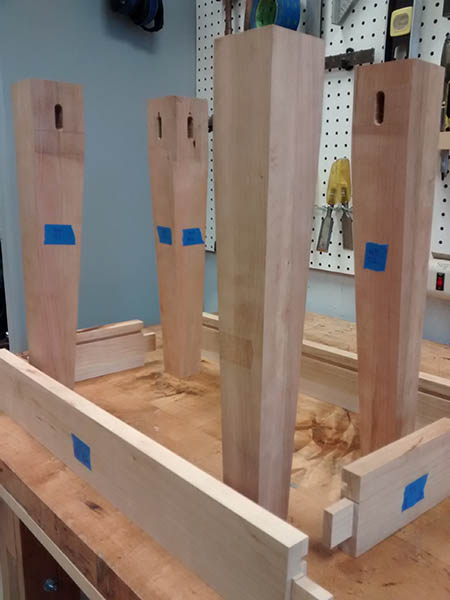
With an expanding number both of woodworkers and of volunteer projects needed for the larger community, there came a need to expand the Wood Shop. Woodworking group members discussed requirements, drew up plans, spoke with the administration of Green Ridge Village, and interviewed contractors. Once they learned the cost of the expansion, they worked with the Mission Support leadership of Presbyterian Senior Living, GRV’s parent organization, to establish a fundraising target, and embarked on the GRV Wood Shop Expansion Campaign.
The expansion campaign aggressively utilized skills of the membership that were not specific to woodcraft: communication and interpersonal skills to foster fundraising and interact with administration; management skills to interact with construction workers, administration, and to efficiently plan and execute those tasks performed by the members. They met their fundraising goal within six months, and work began on the expansion.
Prior to renovation, woodworkers boxed and moved all except the heavy tools. After contractors completed the construction, members of the woodworking group also painted the interior, installed cabinetry and, with the assistance of US-Duct, designed/installed the renovated dust collection system. In less than a year from beginning the project, the Wood Shop has doubled in size, to 1,008 square feet. This encompasses both a new restroom and a new 112-square-foot finishing room with positive air pressure to keep dust from infiltrating the finishing space.
A few notable upgrades include a wash basin, extra cabinetry donated from one of the renovated cottages of GRV, access to the shop that includes an ADA-approved ramp and parking, and a new dust control system. The GRV members pay particular attention to dust control, as some members have breathing problems. The cyclone and the shop vacuums are in constant use, resulting in a level of cleanliness that has come to be expected by our members, and is a source of amazement to visitors.
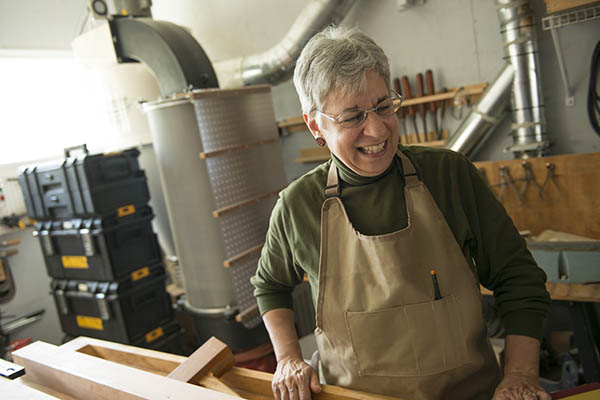
Equipment available in the newly renovated GRV Wood Shop includes a SawStop Professional Cabinet Saw; Laguna 14 Twelve Band Saw; Milwaukee 12-inch Dual-Bevel Sliding Compound Miter Saw; Hammer A3-41 16-inch Jointer/Planer; Bosch router table; Bosch, Craftsman and DeWALT handheld routers; Grizzly belt/disc sander; Porter-Cable 12-speed drill press; Porter-Cable 36-inch lathe and Black & Decker and Craftsman circular saws. Dust collection equipment includes an Oneida Pro Series 1500 3hp cyclone, Oneida Dust Deputy attachments for portable vacuum cleaners and US-DUCT “Clamp-Together ductwork.
Membership fees, dues and donations provide funds for some consumables such as glue, screws and sandpaper. The Wood Shop includes a locker full of various paints, stains and varnishes, some purchased for projects and some donated. Those supplies and materials not on hand are purchased by the administration for specific requested projects, or by the woodworker, as needed.
With approval from administration, the contractors and staff of GRV supply the woodworkers with large quantities of used lumber: studs, plywood and boards left from renovations on campus. The woodworkers pull out the nails and give the lumber new life. For furniture building, they prefer cherry, white or red oak, maple and walnut. The hardwoods are either donated or purchased from a local independent lumber supplier or sawmill; the area is rich in lumber resources. Members shy away from exotic wood because of cost and availability.
Post-upgrade, six woodworkers can now comfortably work on their projects at a time in the shop area. Each woodworker must be certified on each machine he/she uses. Certification is conducted by experienced members who have teaching skills and a passion for safety, and can take from half an hour to three hours per machine. The shop is open 24/7 to members. No sign-in is required; however, there is a sign-up list for briefly checking out small items to work outside the shop.
We follow practices of common courtesy, cleaning up after ourselves, replacing tools to proper storage locations and keeping equipment in good working condition. We respect special requests made by members, such as leaving settings on tools for reasonably short periods of time when a worker must be temporarily away from an on-going project. Members work on their projects individually or with the supervision of a more experienced woodworker. We all help each other, each to our respective abilities.
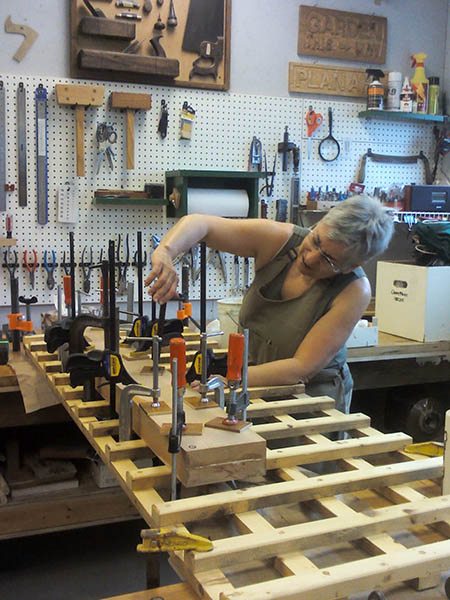
Some statements I have heard from other members of the woodworking group include:
“I never imagined that I could overcome my fears of potentially dangerous power tools. That is a gift from my skilled mentors, that, with their help, I am now able to create from wood these objects of beauty and value to others.”
“Every member in the group plays an important part in volunteering his/her time and energy to help others. There is always at least one member who can solve the problem at hand.”
“Learning the skills in woodworking is a lifelong pursuit, shared with good friends, and good times.”
Some other comments have focused on the woodshop’s resources.
“There are more and better tools here in our Wood Shop than what I had at home.”
“The Wood Shop is always available, 24/7, and is heated/cooled depending on the weather. It is never too hot and never too cold to work on a great project.”
And some have focused on the spiritual aspects of woodworking, or of volunteerism.
“By enjoying woodworking, we spread joy to others.”
“I like volunteering with other woodworkers. It is never lonely here. I am amazed at the expertise in woodworking that my fellow members share.”
“Hand, mind, and heart. Woodworking feeds the soul.”
“The Wood Shop is a sanctuary, spiritually uplifting because woodworking benefits both receiver and giver.”
As for me, I love working with wood, the way it fills my senses, provides a spiritual lift, and challenges me intellectually. I am sure this wonderful activity is contributing to my longevity because there is no end to this journey of discovery with woodworking. My life is enriched by the special relationship I treasure with my mentor and fellow woodworkers, and by the sense of purpose I enjoy from anticipating the new ways that I might give back to the GRV community through refurbishing projects.
The post Woodworking Gains Popularity at this Retirement Village appeared first on Woodworking | Blog | Videos | Plans | How To.
]]>